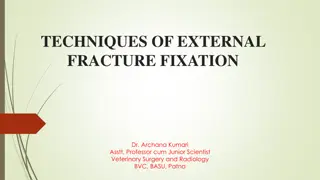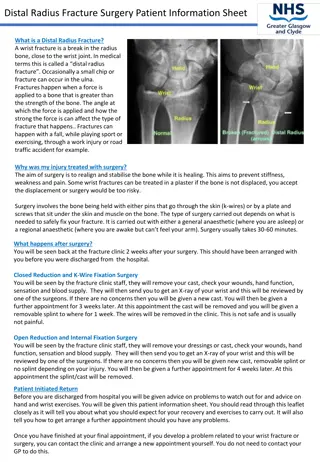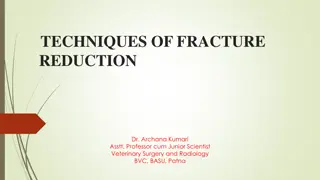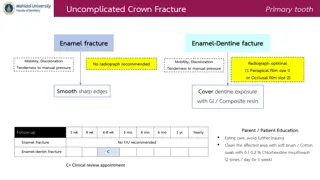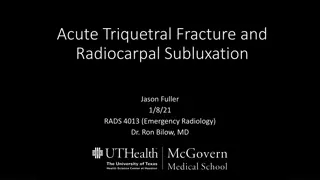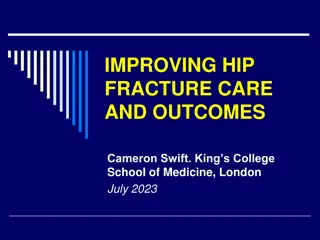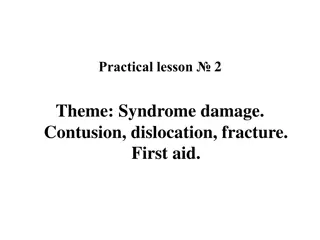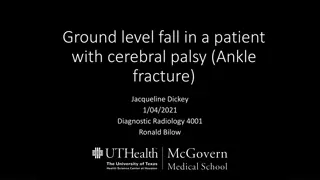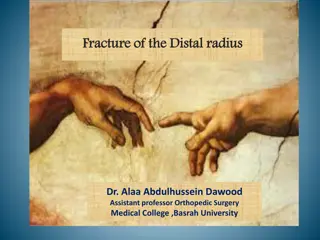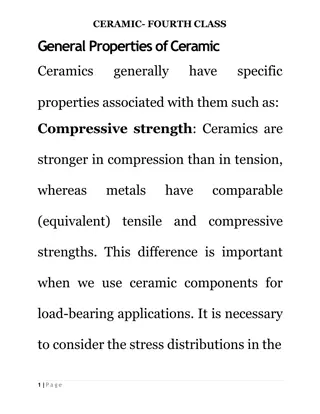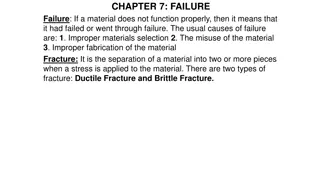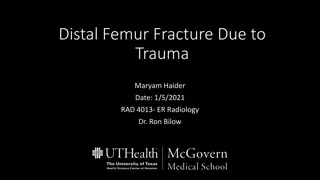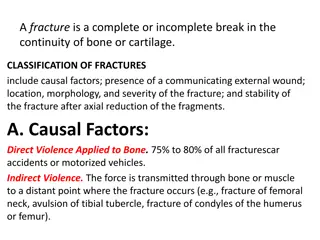
Fracture Management: Understanding Treatment and Recovery
Discover the comprehensive guide to fracture management, covering definitions, causes, treatment options, and prevention measures. Learn about immobilization, closed reduction, surgery, and internal fixation for bone fractures. Whether you require a splint, cast, or surgical intervention, this resource provides essential insights for a successful recovery journey.
Download Presentation

Please find below an Image/Link to download the presentation.
The content on the website is provided AS IS for your information and personal use only. It may not be sold, licensed, or shared on other websites without obtaining consent from the author. If you encounter any issues during the download, it is possible that the publisher has removed the file from their server.
You are allowed to download the files provided on this website for personal or commercial use, subject to the condition that they are used lawfully. All files are the property of their respective owners.
The content on the website is provided AS IS for your information and personal use only. It may not be sold, licensed, or shared on other websites without obtaining consent from the author.
E N D
Presentation Transcript
StudyMafia.Org Fracture Management Submitted To: Submitted By: Studymafia.org Studymafia.org
Table Contents Definition Introduction Management of Fracture Complications of Fracture Management Prevention Measures Conclusion 2
Definition A bone fracture is the medical definition for a broken bone. 3
Introduction Fractures are usually caused by traumas like falls, car accidents or sports injuries. But some medical conditions and repetitive forces (like running) can increase your risk for experiencing certain types of fractures. If you break a bone, you might need surgery to repair it. Some people only need a splint, cast, brace or sling for their bone to heal. 4
Management of Fractures Immobilization If your fracture is mild and your bones did not move far out of place (if it s non- displaced), you might only need a splint or cast. Splinting usually lasts for three to five weeks. If you need a cast, it will likely be for longer, typically six to eight weeks. 6
Management of Fractures Closed reduction More severe breaks require a closed reduction to set (realign) your bones. During this non-surgical procedure, your provider will physically push and pull your body on the outside to line up your broken bones inside you. 7
Management of Fractures Bone fracture surgery Some bone fractures require surgery. Depending on which type of fracture you have and how badly your bones are damaged there are few techniques your surgeon might use. 8
Management of Fractures Internal fixation Your surgeon will realign (set) your bones to their correct position and then secure them in place so they can heal and grow back together. They usually perform what s called an internal fixation, which means your surgeon inserts pieces of metal into your bone to hold it in place while it heals. 9
Management of Fractures External fixation You might need an external fixation. Your surgeon will put screws in your bone on either side of the fracture inside your body then connect them to a brace or bracket around the bone outside your body. 10
Management of Fractures Arthroplasty If you fracture a joint (like your shoulder, elbow or knee) you might need an arthroplasty (joint replacement). Your surgeon will remove the damaged joint and replace it with an artificial joint. The artificial joint (prosthesis) can be metal, ceramic or heavy-duty plastic. 11
Management of Fractures Bone grafting You might need bone grafting if your fracture is severely displaced or if your bone isn t healing back together as well as it should. Your surgeon will insert additional bone tissue to rejoin your fractured bone. 12
Complications of Fracture Management Acute compartment syndrome (ACS): A build-up of pressure in your muscles may stop blood from getting to tissue, which can cause permanent muscle and nerve damage. Malunion: This happens when your broken bones don t line up correctly while they heal. 13
Complications of Fracture Management Nonunion: Your bones may not grow back together fully or at all. Bone infection (osteomyelitis): If you have an open fracture (the bone breaks through your skin) you have an increased risk of bacterial infection. 14
Prevention Measures Always wear your seatbelt. Wear the right protective equipment for all activities and sports. Make sure your home and workspace are free from clutter that could trip you or others. Always use the proper tools or equipment at home to reach things. Never stand on chairs, tables or countertops. 15
Prevention Measures Follow a diet and exercise plan that will help you maintain good bone health. Talk to your provider about a bone density test if you re older than 50 or if you have a family history of osteoporosis. Use your cane or walker if you have difficulty walking or have an increased risk for falls. 16
Conclusion Most people who break a bone make a full recovery and can resume their typical routine after their bone heals. Some fractures can have a long-term impact on your life, especially if you experienced other injuries 17
References Google.com Wikipedia.org Studymafia.org Slidespanda.com
Thanks To StudyMafia.org

